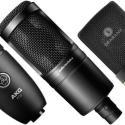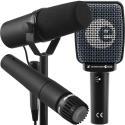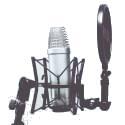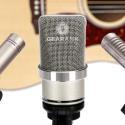Ribbon Mic Uses and How to Get the Best Out of Them
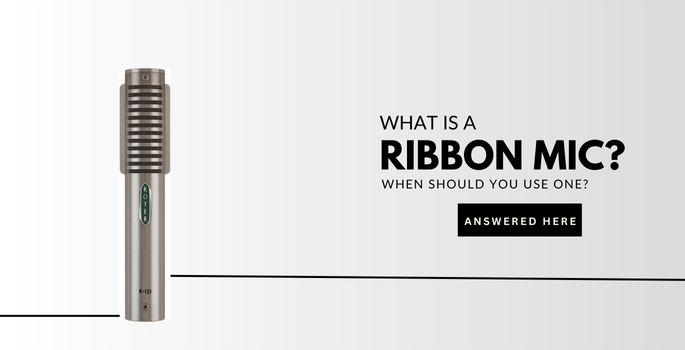
Microphones can be confusing to get into, especially if it's your first experience with them. While they all function the same way fundamentally, different kinds of microphones are used for different applications. Here. we'll ease you into understanding the ribbon mic, and where it fits in this spectrum.
What Is A Ribbon Microphone?
The ribbon mic was invented in the 1920s and was one of the first types of microphones that people could buy. It's a simple design that uses a thin strip of conductive material suspended inside a magnetic field. As the thin strip or "ribbon" moves, an electrical signal is produced.
Ribbon microphones are passive devices. This means they don't require an active current to function.
A ribbon microphone is a finicky device. It is sensitive to impedance, and I recommend getting a mic preamp that is at least three times the output impedance of the mic for the best sound.
The impedance is the resistance of a circuit to an applied voltage. If the preamp's impedance is too low, the mic will need to produce a stronger signal to maintain fidelity.
This delicate balance of the impedance is one of the reasons why ribbon microphones fell out of fashion. That is until active ribbon mics were invented.
Active Ribbon Mic Vs Passive
Active ribbon mics first came about in the 2000's. They work in the exact same way as a passive ribbon mic, but the internal electronics come with an internal preamp to provide a gain boost
A preamp and transformer built into the devices help maintain a consistent impedance. This eliminates the need to match the mic with the mixing board or external preamp. This active version removed the passive ribbon mic's major hindrance.
Because of the impedance problems, passive ribbon mics couldn't be used over long distances without signal loss or noise.
This created a secondary issue. To fully maximize the potential of a ribbon mic, more outboard gear is needed.
An active ribbon microphone is able to circumvent this requirement.
The third issue with a passive ribbon mic is phantom power. While condenser mics need it, it can be damaging to a ribbon mic's internals.
Passive ribbon mics always come with a warning sign to avoid using phantom power. However, active ribbon microphones need it. Do check if your microphone is active or passive before enabling phantom power.
How Do Ribbon Microphones Work?
A ribbon mic uses a thin strip of metal, usually aluminum, suspended between two magnets. As the ribbon vibrates when it picks up sound, the coils around the magnets generate an electric signal. This signal can then be sent over a cable to a preamp or mixing desk.
The electrical voltage needed to power the ribbon is very small. As the power is so weak, the transformer needs to be inside the circuit. Without the transformer, the mic won't have enough power to raise the output to the expected audio levels you get from other microphones.
Ribbon mics use a step up transformer that amplifies the signal voltage. This helps give this type of mic its warm voicing.
Ribbon mics tend to have a flatter frequency than other microphone types. Many ribbon mics emphasize the low end, which is great for voices that need warming up.
Ribbon Microphone Mechanics
Ribbon microphones use a pressure gradient system in a bi-directional polar pattern. This means the sound waves which come in from both sides move the ribbon.
Although the ribbon can pick up sounds from the front and back of the pickup points, the sides of the mic are more or less dead spots. This is why you should direct the audio to the front. Note that some modern ribbon mics have supercardioid or hypercardioid polar patterns.
Structurally, the ribbon transducer or diaphragm is very delicate. To put the fragile nature of this thin piece of metal in perspective, consider human hair. A typical human hair is around 100 microns thick. That translates to 0.001 inches. A ribbon from the ribbon microphone is about 50 times thicker than a human hair.
This tiny yet crucial element of the microphone can break extremely easily. Because of the delicate nature of these microphones, It's not advisable to use ribbon mics for loud sound sources.
This can be a problem if the aforementioned preamp is not matched to the ribbon mic itself. Having this SPL limit requires proper impedance matching with the preamp.
Thankfully, modern Ribbon mics are now more robust. You can shop ribbon microphones from popular mic brands like Royer Labs, Beyerdynamic, Shure, SE Electronics, Audio Technica, and the list goes on and on.
Some of the best ribbon mics of today include market favorites like the Royer R-121, Beyerdynamic m 160, Coles 4038, Shure KSM313/NE, and more.
When Should You Use A Ribbon Microphone?
The best use of a ribbon microphone is to create a warm or vintage sound. This mic has a silky smooth tone with pleasing midrange harmonics that results in a more natural sound.
Strident singing vocals benefit greatly from the inherent warmth of the ribbon mic. It's no surprise that this is one microphone that gets a lot of love in broadcast.
Other uses include drum overheads, just don't use it for loud parts like kick drums, as they tend to push air that push air, like kick drums.
Using two ribbon mics in stereo is still considered the benchmark for capturing sound in a room. This is called the Blumlein configuration, which is still widely used to this day.
I wouldn't recommend using a ribbon microphone during live performances or on tour. They should be kept in the studio due to their fragile nature. They are more easily damaged than condenser microphones and dynamic microphones.
How To Care For A Ribbon Microphone
Because ribbon mics are so delicate and fragile, there are things to note when maintaining one:
Don't Blow On The Ribbon
Blowing on it can be enough to break the thin aluminum strip. This is one reason why ribbon microphones shouldn't be used outdoors.
Don't Lay A Ribbon Microphone Down
Because of the powerful magnetic force that makes up the microphone's contraption, laying the ribbon mic on a surface can lead to disaster. Any microfibers, like dust, can get caught in the element and cause degradation.
Use A Windscreen Protector
If you absolutely have to use your microphone outdoors, use a windscreen protector. This will protect the ribbon from unexpected wind and damp air. Unfortunately, this dampens the frequency response even further, resulting in a darker sound. I don't recommend doing so.
Check that your Mixer or Preamp's Phantom Power is OFF Before Plugging in
As we said before, phantom power can harm a passive ribbon mic, but an active ribbon microphone can handle phantom power.
Avoid Heat And Humidity
Lastly, the ribbon of your microphone can get damaged in hot rooms and can dampen in high-humidity rooms. Both effects will either lead to the damage needing to be repaired or the entire element replaced.
To avoid this type of damage, consider keeping the mic in a cool enough room along with a dehumidifier.
You should also avoid keeping the microphone in direct sunlight.
Modern Ribbon Microphones - Sensitivity And Proximity Effect
Even the best ribbon microphones are prone to proximity effect.
The proximity effect is when the low-frequency builds up in a sound source in close proximity. This increase in the low end can be beneficial at times, but it can also lead to undesirable results.
For ribbon microphones, proximity effect is greatly emphasized. It's important to note that going for this sound might damage the mic with high SPL sources.
In contrast to older ribbon mics, newer ones can handle proximity better, but still not to the same extent as other mic types.
Gain And Ribbon Microphones
Gain is how much a signal is boosted by a preamp. Ribbon mics tend to have the same gain requirement as most dynamic microphones, including the shotgun mic.
Preamps need to be strong enough to boost the signal levels to optimum amounts without adding too much unwanted noise.
Aim for a decibel level of + 25, and then check to see if the noise level is kept to a minimum.
Final Thoughts
Ribbon microphones are great for recreating the vibe of vintage audio. However, because they are delicate, it won't be worth buying these microphones unless you pick top-quality brands. This means being careful when selecting second-hand microphones too.
Modern ribbon microphones tend to have sturdier materials. Active ribbon microphones also circumvent the need for a strong and clean preamp.
If you need a vintage smooth sounding mic to add to your collection, consider getting a good ribbon mic.
Frequently Asked Questions
What Are Ribbon Mics Used For?
Ribbon mics are best used for capturing acoustics with room ambiance. For example, recording acoustic instruments, drums, strings, bass, and more.
Are Ribbon Mics Good For Vocals?
Yes. A ribbon mic is a great choice for recording the warmth of your vocals. They are perfect for jazz or soul music specifically.




